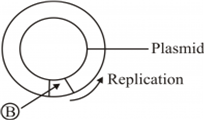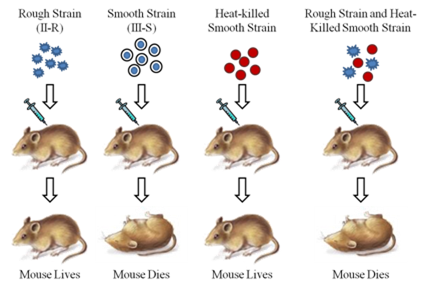 Short Answer Type
Short Answer Type(a) Identify (A) and (B) illustrations in the following:
i. 
ii. 
(b) Write the term given to (A) and (C) and why?
(c) Expand PCR. Mention its importance in biotechnology.
Rearrange the following in the current sequences to accomplish an important biotechnological reaction :
(a) In vitro synthesis of region of DNA of interest
(b) Chemically synthesized oligonucleotides
(c) Enzyme DNA-polymerase
(d) Complementary region of DNA
(e) Genomic DNA template
(f) Nucleotides provided
(g) Primers
(h) Thermostable DNA-polymerase (from Thermus aquaticus)
(i) Denaturation of ds-DNA
Why is it not possible for an alien DNA to become part of a chromosome anywhere along its length and replicate normally?
Name the enzymes that are used for the isolation of DNA from bacterial and fungal cells for recombinant DNA technology.
Name and describe the technique that helps in separating the DNA fragments formed by the use of restriction endonuclease.
 Long Answer Type
Long Answer Type(a) Describe the various steps of Griffith’s experiment that led to the conclusion of the ‘Transforming Principle’.
(b) How did the chemical nature of the ‘Transforming Principle’ get established?
Grifith's experiment
i. Streptococcus pneumoniae (pneumococcus) bacteria were grown on a culture plate, some produces smooth shiny colonies (S) while others produces rough colonies (R). This was because the S strain bacteria has a mucous (polysaccharide) coat, while R strain does not.
Mice infected with the S strain (virulent) die from pneumonia infection but mice infected with the R strain do not develop pneumonia.
S strain ---> Inject into mice ----> Mice die
R strain ----> Inject into mice ----> Mice live
The virulet S strain bacteria were killed by heating them. It was observed that heat killed S strain bacteria injected into mice did not kill them.
S strain (heat-killed) ----> Inject into mice ----> Mice live
When a mixture of heat-killed S and live R bacteria was injected, the mice died.
S strain (heat-killed) + R strain (live) ----> Inject into mice ----> Mice died. Moreover, living S bacteria was recovered from the dead mice.
The experiment concluded that the R strain bacteria had somehow been transformed by the heat-killed S strain bacteria and that some ‘transforming principle’, transferred from the heat-killed S strain, had enabled the R strain to become virulent. It was thought that this must be due to the transfer of the genetic material.
b. Prior to the work of Oswald Avery, Colin MacLeod and Maclyn McCarty it was thought that the genetic material was a protein. They worked to determine the biochemical nature of ‘transforming principle’ in Griffith’s experiment. They purified biochemicals (proteins, DNA, RNA, etc.) from the heat-killed S cells to see which ones could transform live R cells into S cells. They discovered that protein-digesting enzymes (proteases) and RNA digesting enzymes (RNases) did not affect transformation, so the transforming substance was not a protein or RNA. Digestion with DNase did inhibit transformation, suggesting that the DNA caused the transformation. They concluded that DNA is the hereditary material and that DNA alone from S bacteria caused R bacteria to become transformed.
